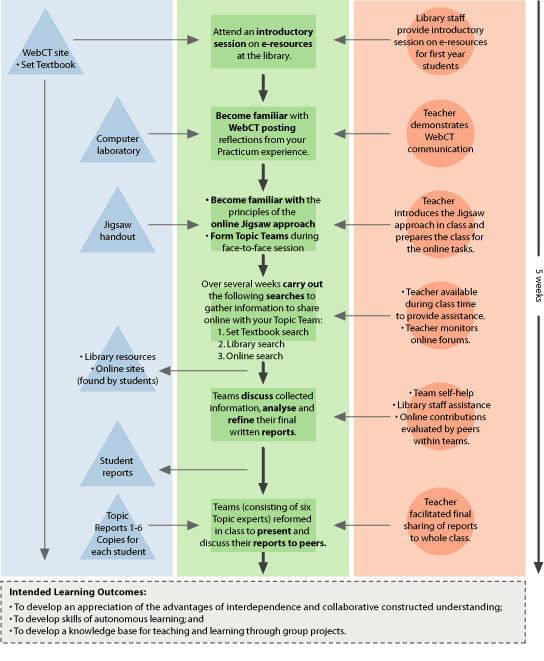|
WHAT THE STUDENTS DO
The subject has been designed to broaden student-to-student
contact by organising topic groups across three classes. The
original learning setting was designed for a cohort of 70
first year, Bachelor of Education (BEd) students drawn from
a first year enrolment of approximately 200 students. Of the
seven first year class groups, three classes undertook this
learning design. Each class comprised approximately 24 students,
which broke into 6 topic teams of 4 students. In this 3 class
design, this meant that each topic team had 12 students. Each
topic team from each class collaborated online to investigate
their topic. Students were randomly assigned to one of six
topics. Of these six topics, three appeared in the end-of-semester
examination. The six topics were chosen to reflect the breadth
of unit content and were adapted from the six final exam questions.
For the purpose of this design students’ practical teaching
experiences were used as the vehicle to develop the technical
skills of using WebCT during face-to-face workshops in the
university computer laboratory. Therefore, after completing
their two-week professional teaching experience, students
followed-up by sharing and discussing these experiences with
their peers, in conjunction with the introduction to WebCT.
Students were guided to share one positive and one negative
experience online within their class group. This would ensure
that students felt secure within their class group having
established relationships during semester one. This sharing
provided the opportunity for ironing out any technical difficulties
that may have arisen in using WebCT Bulletin Board.
(This initial activity, that is the sharing of positive and
negative experiences, is conducted as a way for students to
become familiar with the online technology – thus it
is in addition to the Jig-saw activity.)
The Jigsaw activity:
Following the WebCT introductory workshop, over a period of
five weeks, the groups met online to discuss key issues and
identify problems and solutions relating to their topic.
Over the five weeks students were directed to carry out searches
to gather information on their topic. The first task was for
students to find relevant information in the set text and
share this information online with their team. The second
task was for students to search for other texts in the main
university library and to summarise the information found
and to post this to their team. Next the students were asked
to search for journal articles that related to their topic
and finally they were expected to search on the internet for
relevant websites and share this information with their team.
Not only were students asked to gather information but at
the same time they were to critically assess the information
found and discuss this analysis within the team.
In addition to gathering information, students were asked
to allocate roles within their teams to take responsibility
for collating and refining the team’s analysis and finally
jointly constructing a text that would be shared within their
class group.
Over the remaining two weeks prior to the test, within their
class group, students met in their expert team to refine their
final analysis. They then reformed into teams consisting of
at least one expert in each topic area. This meant that the
newly formed teams were able to share their insights and provide
explanations for their peers. This was the final stage of
putting the pieces of the jigsaw together providing comprehensive
understanding of all six topic areas.
SIGNIFICANCE OF ORDER
For students with little on no Computer Mediated Communication
experience, it is essential that they have the opportunity
to practice communicating in this mode prior to the online
jigsaw. As students are given lectures on the topic areas,
it is not essential that their research follows the sequence
of researching the textbook, the library and then online in
that order. However, it is critical that they collaborate
on a frequent basis in compiling their joint analysis.
CRITICAL ACTIVITIES
Firstly, the forming of the topic teams in each class is critical
and could be undertaken at random, however it may be necessary
to consider the individual strengths and weaknesses of the
students to balance team membership.
Depending on the students’ expertise the introductory
WebCT workshop could be optional.
What is critical is students’ ability to research and
critically assess their topic areas.
In terms of developing interdependence it is essential that
students are provided with opportunities to share and discuss
information.
|
